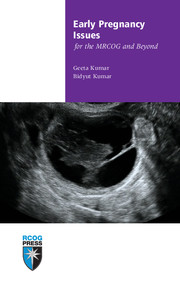Book contents
- Frontmatter
- Contents
- Dedication and acknowledgement
- About the authors
- Abbreviations
- Preface
- 1 Embryogenesis and physiology
- 2 Miscarriage
- 3 Recurrent miscarriage
- 4 Ectopic pregnancy
- 5 Trophoblastic disease
- 6 Hyperemesis gravidarum
- 7 Abdominal and pelvic pain in early pregnancy
- 8 Prescribing issues
- 9 Ultrasound and screening
- Further reading
- Index
- Published titles in the MRCOG and Beyond series
7 - Abdominal and pelvic pain in early pregnancy
Published online by Cambridge University Press: 05 July 2014
- Frontmatter
- Contents
- Dedication and acknowledgement
- About the authors
- Abbreviations
- Preface
- 1 Embryogenesis and physiology
- 2 Miscarriage
- 3 Recurrent miscarriage
- 4 Ectopic pregnancy
- 5 Trophoblastic disease
- 6 Hyperemesis gravidarum
- 7 Abdominal and pelvic pain in early pregnancy
- 8 Prescribing issues
- 9 Ultrasound and screening
- Further reading
- Index
- Published titles in the MRCOG and Beyond series
Summary
Abdominal pain in early pregnancy brings fear and uncertainty to every expectant mother and hence most women will present sooner to health professionals than if they were not pregnant. Early pregnancy is defined here as the period from conception to the end of first trimester. As such the primary concern in the mind of a gravid woman in such circumstances is that of miscarriage or an ectopic pregnancy. It is important to remember, however, that abdominopelvic pain, although common during early pregnancy, may accompany serious or minor disorders and includes conditions which are not directly related to pregnancy.
Many pregnant women presenting with pain are seen in an early pregnancy assessment unit and will result in a diagnosis of threatened, inevitable, incomplete or complete miscarriage or, in some cases, an ectopic pregnancy. Some of these cases present with complaints of vaginal bleeding, which most often serves as an indicator of the possible cause.
Apart from other medical or surgical causes, sepsis can also lead to abdominopelvic pain. The eighth report of the Confidential Enquiries into Maternal Deaths in the UK (2006–2008) reported 29 deaths from genital tract sepsis, of which seven were in early pregnancy (arising before 24 completed weeks of gestation). Two women died from septic miscarriage and two after a termination of pregnancy. In this report, there were eighty-eight indirect maternal deaths from causes other than cardiac disease. Nine of these were due to disease of the gastrointestinal tract, of which two were from complications of duodenal ulcer.
- Type
- Chapter
- Information
- Early Pregnancy Issues for the MRCOG and Beyond , pp. 81 - 102Publisher: Cambridge University PressPrint publication year: 2011



